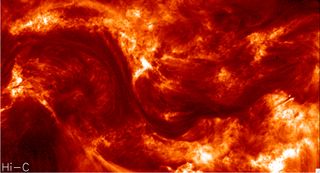NASA Telescope Snaps Best-Ever Pictures of Sun's Atmosphere

A NASA telescope snapped the best-ever images of the sun's million-degree outer atmosphere during a brief spaceflight this month, agency officials say.
The High Resolution Coronal Imager, or Hi-C for short, captured 165 stunning pictures of the sun's corona during a 10-minute suborbital flight on July 11. The telescope focused its gaze on a large sunspot, a temporary blemish on the sun that appears dark because it is cooler than the rest of the solar surface.
Huge solar flares and blasts of plasma called coronal mass ejections (CMEs) often erupt from sunspots. Hi-C's photos could help researchers better understand the solar atmosphere and its potential impacts on Earth, project scientists said.
"We have an exceptional instrument and launched at the right time," Jonathan Cirtain, a senior heliophysicist at NASA's Marshall Space Flight Center in Huntsville, Ala., said in a statement. "Because of the intense solar activity we're seeing right now, we were able to clearly focus on a sizeable, active sunspot and achieve our imaging goals." [Photos: Sunspots on Earth's Closest Star]
Hi-C weighs just 464 pounds (210 kilograms) and is 10 feet (3 meters) long. It launched from the White Sands Missile Range in New Mexico atop a 58-foot (18-m) sounding rocket, then parachuted safely back to Earth and was retrieved shortly thereafter.
The telescope snapped its images in extreme ultraviolet light, a high-energy wavelength that researchers said is optimal for viewing the sun's sizzling-hot corona. Temperatures there can reach 3.5 million degrees Fahrenheit (2 million degrees Celsius), making the corona more than 20 times hotter than the sun's actual surface.
Hi-C's photos are the highest-resolution images ever taken of the corona, NASA officials said. They're about five times more detailed than those snapped by the Atmospheric Imaging Assembly (AIA) instrument flying aboard NASA's Solar Dynamics Observatory spacecraft.
Sign up for the Live Science daily newsletter now
Get the world’s most fascinating discoveries delivered straight to your inbox.
AIA can see structures on the sun's surface with a resolution of about 675 miles (1,086 kilometers), while Hi-C can resolve down to 135 miles (217 km) or so. However, AIA observes the sun in 10 wavelengths of light, while Hi-C looked solely in the extreme ultraviolet on its recent flight.
Hi-C's brief suborbital sojourn demonstrates that sounding rockets can help researchers do good science at relatively low cost, NASA officials said.
"These revolutionary images of the sun demonstrate the key aspects of NASA's sounding rocket program, namely the training of the next generation of principal investigators, the development of new space technologies and scientific advancements," said Barbara Giles, director for NASA's Heliophysics Division at NASA Headquarters in Washington, D.C.
The sun is in an active phase of its 11-year space weather cycle. Experts expect activity in the current cycle, known as Solar Cycle 24, to peak next year.
This story was provided by SPACE.com, a sister site to LiveScience. Follow SPACE.com for the latest in space science and exploration news on Twitter @Spacedotcom and on Facebook.


